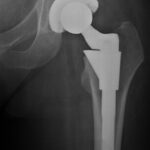
Total Knee Replacement FAQ
Osteoarthritis is a progressive, degenerative disease in which the cartilage of the knee or hip slowly wears away. Cartilage serves as a cushion between the bones of the joint, and when the cartilage of the joint wears away due to osteoarthritis, the resulting pain and inflammation can be debilitating.
Your chances of osteoarthritis of the weightbearing joints of the knee and hip increase with age; the condition most often affects middle-aged and older people. Osteoarthritis may first appear between the ages of 30 and 40, though symptoms may not be present in the early stages. Later in life, many Americans will experience joint pain due to arthritis that can make enjoying life very challenging.
When do I need a knee replacement?
When traditional, non-surgical treatment options have failed to manage the pain from an arthritic hip or knee, joint replacement (arthroplasty) can be a valuable tool. The surgeons and staff at Orthopedic Performance Institute are dedicated to combating the effects of osteoarthritis and are determined to guide patients back to an active, enjoyable lifestyle.
We combine patient preparation with advanced surgical techniques, innovative pain management tools, and enhanced rehabilitation strategies to revitalize the lives of patients every day.
Our total joint replacement program allows patients to return to an active, enjoyable life with minimal downtime. The foundation of our program is extensive patient education coupled with comprehensive support to ensure success from the beginning. Prepare to excel!
A knee replacement (also called knee arthroplasty) might be more accurately termed a knee “resurfacing” because only the surface of the bones are actually replaced.
There are four basic steps to a knee replacement procedure:
- Prepare the bone. The damaged cartilage surfaces at the ends of the femur and tibia are removed along with a small amount of underlying bone.
- Position the metal implants. The removed cartilage and bone is replaced with metal components that recreate the surface of the joint. These metal parts may be cemented or “press-fit” into the bone.
- Resurface the patella. The undersurface of the patella (kneecap) is cut and resurfaced with a plastic button. Some surgeons do not resurface the patella, depending upon the case.
- Insert a spacer. A medical-grade plastic spacer is inserted between the metal components to create a smooth gliding surface.
What does a joint replacement surgery involve?
Patients should plan on a 1-2 night hospital stay after knee replacement surgery. We then allow the patient to fully recover at home with the assistance of in-home physical therapy and nursing services as needed. A successful recovery is accomplished through extensive patient education and preparation combined with minimally invasive surgical techniques, advanced pain management therapies and rehabilitative support. Surgery itself takes about 1.5 hours; patients should plan to be up and walking with the therapist in the hospital on the day of surgery.
How is pain managed during surgery?
General anesthesia, given by IV, is administered by the anesthesiologist for surgery. Oral medications and additional injectable medications may be given as needed for pain or relaxation.
When should I expect to go home?
You can expect to stay 1-2 nights in the hospital. Most patients are then discharged home with oral pain medication. These medications, when taken as directed, typically provide excellent pain relief at home. A physical therapist will walk with you prior to discharge from the hospital to ensure you are stable and comfortable. It is important to follow the discharge instructions that you will be provided after surgery and that will be discussed in detail in this booklet. Specifically follow the instructions for post-operative pain management to ensure adequate pain relief once you are home.
Who is a good candidate for outpatient joint replacement surgery?
The success of total joint replacement surgery is dependent on several factors. One of the most imperative factors is preparation and education of the patient. Our team is dedicated to ensuring our patients achieve their goals of returning to an active, pain free lifestyle but your understanding, participation and commitment are imperative to the success of your procedure. These guidelines are the basis of our patient selection strategy for joint replacement surgery. Speak with one of our experienced providers to determine if you are a good candidate for joint replacement surgery.
• Good health
• Appropriate body weight (BMI <40)
• Non-smoker
• Arthritis that has failed to respond to conservative treatment
What are the risks associated with joint replacement surgery?
Our surgeons perform hundreds of successful joint replacement surgeries each year and our staff is dedicated to the safety of each of our patients. However, there are potential complications associated with any surgery. Below are some of the risks associated with joint replacement surgery and the precautions we take to minimize these concerns.
Infection. Prior to surgery, your pre-operative testing will help identify active infections and potential sources of infection. These will be treated appropriately. Surgery will not take place if there is any potential active infection present (ex. skin wounds, respiratory infections, bladder infections). During surgery, our team follows meticulous sterile technique. Patients are treated with IV antibiotics and the surgical site is thoroughly cleansed. Post-operatively, we provide detailed instructions regarding wound care and recommend avoiding dental procedures for six months, including routine cleanings due to the increased risk of joint infection.
If you think you’re a candidate for total knee replacement surgery, contact the Orthopedic Performance Institute.

 Previous Post
Previous Post Next Post
Next Post




